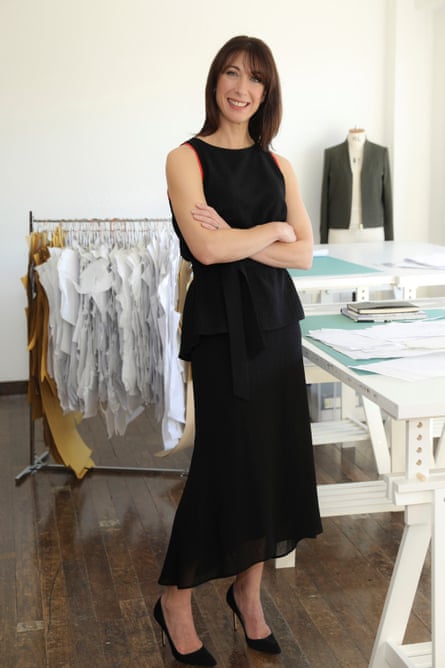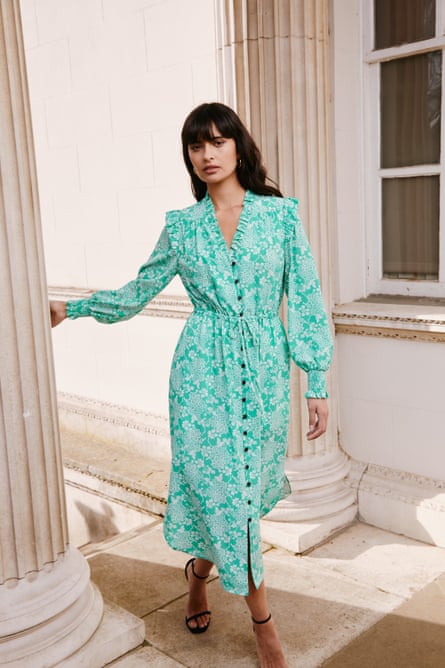Almost nine years after launching her womenswear brand, Cefinn, following Brexit, the designer Samantha Cameron has announced she will be “winding down future operations” in the coming months.
The wife of the former prime minister David Cameron cited “turbulence in the fashion wholesale factor, ongoing cost pressures and international trading restrictions”. It had become increasingly difficult to “achieve the level of growth needed to reach a profitable position”, she said in a statement. Her final collection will go on sale online and in her two London shops at the end of the month.
Cefinn, which is an amalgamation of their children’s names, launched in autumn 2016, three months after David resigned over the Brexit vote. Formerly the creative director of the British brand Smythson, Cameron took a pattern-cutting course while her husband was planning the EU referendum. Against all odds – and public sentiment – it started well.

Self-funded and with just 40 looks, which ran up to £400 for a coat, the brand hard-launched with a handful of pieces – sleeveless A-lined culottes, trouser suits in bright colours and a flattering tie-waist dress in her trademark windowpane print – in Vogue’s December issue.
It helped that her sister, Emily Sheffield, was then the magazine’s deputy editor, her cousin is the interior designer Cath Kidston and her mother, Annabel Astor, co-founded the interiors company Oka. But equally, its “C-suite chic” filled a hole in the market, according to Joy Montgomery, Vogue’s online commerce editor. “It understood that so many women just wanted easy-to-style, flattering staples that weren’t tethered to the changing tides of the seasonal trend cycle,” she said.
Cameron said the idea had been to create trend-free clothing for women who moved between roles, in fabrics that didn’t need to be dry-cleaned. One of the few brands with a designer who was as much a visual ambassador of the clothes as anyone who wore then, Cefinn became inextricably linked with Cameron’s own style. Her collarbone-to-calf printed dresses looked as at home in the Cotswolds as the courtroom, and were worn by the Princess of Wales and Akshata Murty.
Among the bestsellers was the whimsically named Rosie dress, whose button-down front is sewn shut so as to avoid a gaping bust.
In 2020 she successfully launched knitwear. One item, a £150 tabard, even had a waiting list. She went on to model the pieces on social media, twirling desk-side in her white-walled office.
Yet in some ways, the latest news isn’t surprising. Despite its glossy start, 18 months into the business, in 2018, Cefinn lost more than £500,000. Later that year, it secured £2.5m from fundraisers including the Tory peer and party donor David Brownlow, who became company director and bankrolled the Johnsons’ Downing Street makeover. But by 2020, thanks in part to Covid, losses were mounting, and by 2021 it had suffered its fourth consecutive annual loss.

In 2022 revenues hit £3.8m, but the company went through various supply-chain problems after the UK agreed its post-Brexit EU trade deal – some of which she diplomatically outlined in a Radio 4 interview as “teething issues” – as well as escalating costs and the removal of tax-free shopping for tourists. Compounded by unforeseen international trading restrictions, the market simply conspired against it.
Cefinn’s story is a familiar one for several independent British labels whose outlook has been hit by the whims of the fashion industry, among them The Vampire’s Wife and Roksanda, which were particularly affected by the collapse in March of the online stockist Matchesfashion.
“Ultimately, it came up against the same challenge that has confronted every high-street and mid-priced brand in recent years,” Montgomery said. “How to stand out in an increasingly crowded marketplace in which content is king and customer loyalty is an ever-shifting target.”
after newsletter promotion
The retail analyst and founder of Savvy, Catherine Shuttleworth, agreed. “Brands rely on influencers and social media,” she said. With just over 80,000 followers on social media, Cefinn’s online presence was relatively low-key.
According to the Office for Budget Responsibility, customers in Cefinn’s 45-54 age bracket have the highest disposable income. But the safe formula that made Cefinn appealing “doesn’t stand a chance when John Lewis and M&S costs half the price”, Shuttleworth said. This week, John Lewis’ own-brand knitwear sales were up more than 50% week-on-week. Among its most popular offerings? Sleeveless tabard vests.
Those with bigger budgets have moved on to brands such as Rixo, whose vintage-inspired dresses have cross-generational appeal, and ME+EM, which, in an ironic twist, has been worn by Cameron’s Labour counterpart, Victoria Starmer, and Angela Rayner and opened in the US.
“It’s notable that [British] high-street brands have been expanding their higher-priced offering,” Montgomery said of the newly normal four-figure coat.
It’s possible that it became too difficult to separate the designer from her personal history. Cameron is, after all, still married to the man who – among many things – left office after losing the Brexit vote and has remained a broadly disliked public figure.
There is no overt branding on the clothes, but some looks are recognisably Cefinn. Shuttleworth disagrees that anti-Tory sentiment extends to sales: “I think if the product is right, that doesn’t matter,” she said.
Yet one customer, who preferred to stay off the record, told the Guardian she simply couldn’t wear her navy Cefinn dress to work “in case someone asked her where it was from”.

 2 months ago
56
2 months ago
56

















































